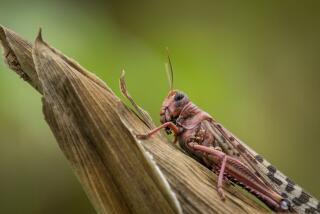In the eye of the swarm
- Share via
As a member of the New Jersey Institute of Technology’s Swarm Lab, Simon Garnier studies how living things coordinate their behavior in large groups.
The assistant biology professor recently used a swarm of micro-robots to dissect the behavior of invasive Argentine ants (read the robot ant story here), and has also studied nomadic army ants in the jungles of Panama to observe their extraordinary bridge-building capability.
In one of two papers published in PLOS Computational Biology on Thursday, Garnier and colleagues from Princeton University described the mechanics of how army ants use their own bodies to erect a bridges over gaps, allowing their fellow ants to walk over them.
“Twenty seconds. It’s all the time that the army ants need to build and dismantle their bridges,” Garnier said. “However, these bridges can last for several minutes, maybe hours, as long as there is enough traffic on the trail,” he said.
Once the bridge ants disassemble, they quickly follow the rest of their colony. Scientists say the behavior is a form of “living architecture.”
Currently, Garnier is studying the behavior of slime molds and their strategy for finding food.
Slime molds, which can exist both as single cells and collective systems, send out arms, or pseudopods, in search of food. When none is found, the organism must determine whether to reach further, in hopes of finding food just beyond its grasp, or use that energy to search in a different area.
Garnier said he is trying to determine if there is an algorithm for this behavior, which he likened to the dilemma a gambler faces playing slot machines in Vegas.
“The gambler has to decide how much time to invest in a particular machine to maximize a potential for a reward, or move on to another one-armed bandit,” Garnier said. “The slime mold has to determine the same balance. According to our preliminary findings, slime molds do better than gamblers.”
While he said he enjoys working in the field and studying living creatures, Garnier said there was a certain advantage to working with robots during the Argentine ant study.
“It’s a lot easier,” Garnier said. “When you have ants, they’re always trying to escape. Once they get loose, they go everywhere.”
Return to Science Now blog.
Follow me on Twitter @montemorin





